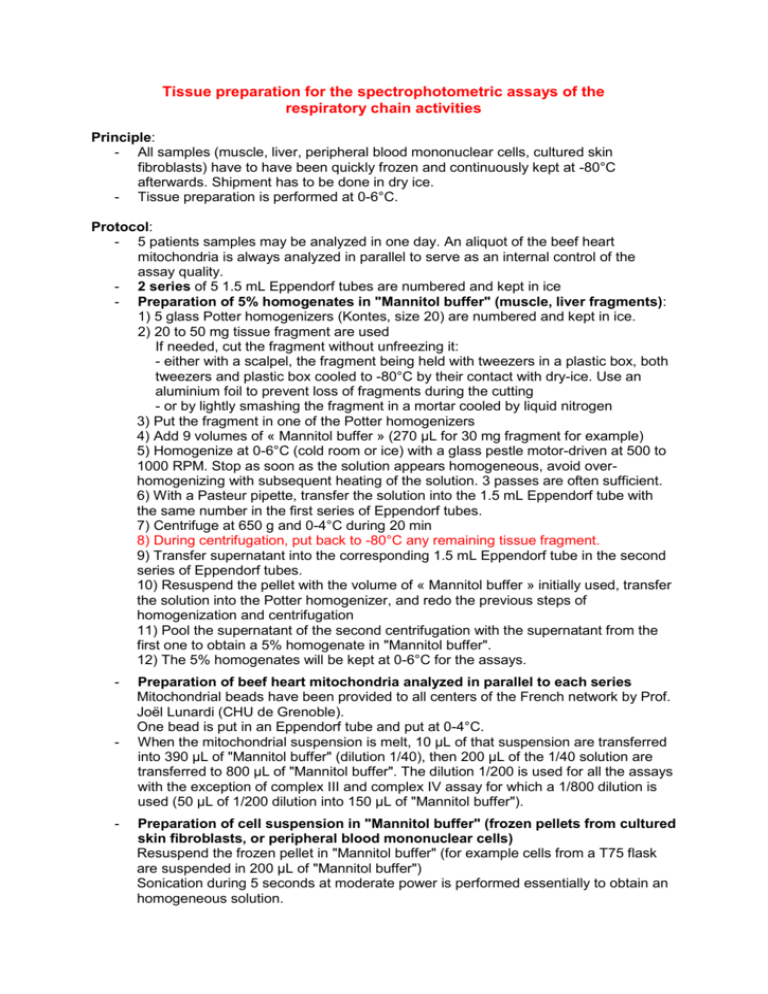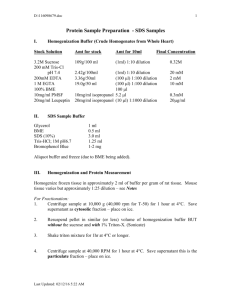Tissue_preparation
advertisement

Tissue preparation for the spectrophotometric assays of the respiratory chain activities Principle: - All samples (muscle, liver, peripheral blood mononuclear cells, cultured skin fibroblasts) have to have been quickly frozen and continuously kept at -80°C afterwards. Shipment has to be done in dry ice. - Tissue preparation is performed at 0-6°C. Protocol: - 5 patients samples may be analyzed in one day. An aliquot of the beef heart mitochondria is always analyzed in parallel to serve as an internal control of the assay quality. - 2 series of 5 1.5 mL Eppendorf tubes are numbered and kept in ice - Preparation of 5% homogenates in "Mannitol buffer" (muscle, liver fragments): 1) 5 glass Potter homogenizers (Kontes, size 20) are numbered and kept in ice. 2) 20 to 50 mg tissue fragment are used If needed, cut the fragment without unfreezing it: - either with a scalpel, the fragment being held with tweezers in a plastic box, both tweezers and plastic box cooled to -80°C by their contact with dry-ice. Use an aluminium foil to prevent loss of fragments during the cutting - or by lightly smashing the fragment in a mortar cooled by liquid nitrogen 3) Put the fragment in one of the Potter homogenizers 4) Add 9 volumes of « Mannitol buffer » (270 µL for 30 mg fragment for example) 5) Homogenize at 0-6°C (cold room or ice) with a glass pestle motor-driven at 500 to 1000 RPM. Stop as soon as the solution appears homogeneous, avoid overhomogenizing with subsequent heating of the solution. 3 passes are often sufficient. 6) With a Pasteur pipette, transfer the solution into the 1.5 mL Eppendorf tube with the same number in the first series of Eppendorf tubes. 7) Centrifuge at 650 g and 0-4°C during 20 min 8) During centrifugation, put back to -80°C any remaining tissue fragment. 9) Transfer supernatant into the corresponding 1.5 mL Eppendorf tube in the second series of Eppendorf tubes. 10) Resuspend the pellet with the volume of « Mannitol buffer » initially used, transfer the solution into the Potter homogenizer, and redo the previous steps of homogenization and centrifugation 11) Pool the supernatant of the second centrifugation with the supernatant from the first one to obtain a 5% homogenate in "Mannitol buffer". 12) The 5% homogenates will be kept at 0-6°C for the assays. - - - Preparation of beef heart mitochondria analyzed in parallel to each series Mitochondrial beads have been provided to all centers of the French network by Prof. Joël Lunardi (CHU de Grenoble). One bead is put in an Eppendorf tube and put at 0-4°C. When the mitochondrial suspension is melt, 10 µL of that suspension are transferred into 390 µL of "Mannitol buffer" (dilution 1/40), then 200 µL of the 1/40 solution are transferred to 800 µL of "Mannitol buffer". The dilution 1/200 is used for all the assays with the exception of complex III and complex IV assay for which a 1/800 dilution is used (50 µL of 1/200 dilution into 150 µL of "Mannitol buffer"). Preparation of cell suspension in "Mannitol buffer" (frozen pellets from cultured skin fibroblasts, or peripheral blood mononuclear cells) Resuspend the frozen pellet in "Mannitol buffer" (for example cells from a T75 flask are suspended in 200 µL of "Mannitol buffer") Sonication during 5 seconds at moderate power is performed essentially to obtain an homogeneous solution. - Protein determination Prepare a 1/5 dilution in PBS of homogenates and cells suspension. Measure the protein content of 10 µL of these 1/5 dilutions and of 10 µL of the 1/40 dilution of beef heart mitochondrial preparation using Pierce BCA kit and a 2 to 0.0625 mg/mL BSA standard curve. Using "Mannitol buffer", adjust the protein concentration to 2 mg/mL for the homogenates and cells suspensions. The protein concentration of the 1/40 dilution of the mitochondrial bead should be 1 mg/mL. If needed, modify the calculations of the rate of reaction.









